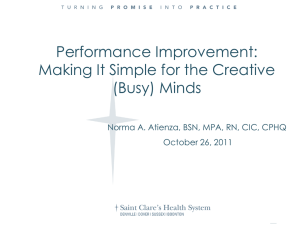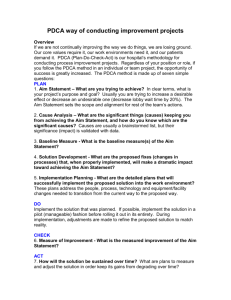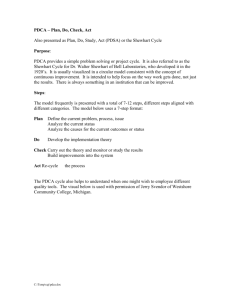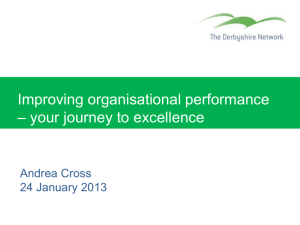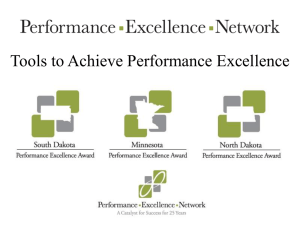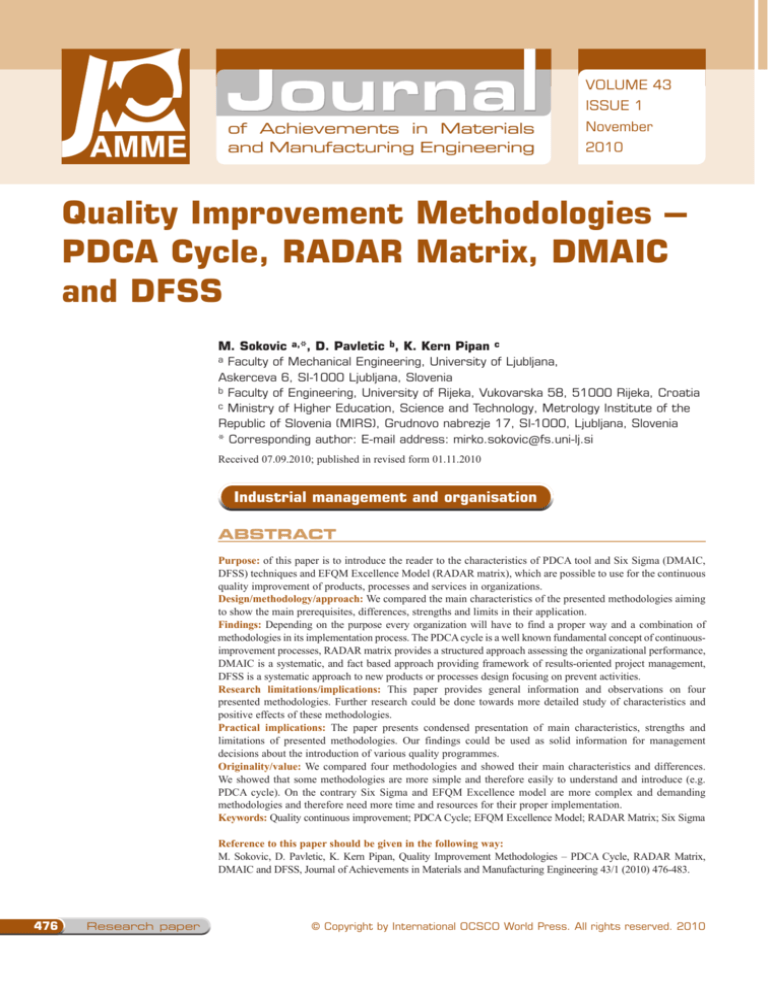
VOLUME 43
ISSUE 1
of Achievements in Materials
and Manufacturing Engineering
November
2010
Quality Improvement Methodologies –
PDCA Cycle, RADAR Matrix, DMAIC
and DFSS
M. Sokovic
a,*,
D. Pavletic b, K. Kern Pipan
c
a
Faculty of Mechanical Engineering, University of Ljubljana,
Askerceva 6, SI-1000 Ljubljana, Slovenia
b Faculty of Engineering, University of Rijeka, Vukovarska 58, 51000 Rijeka, Croatia
c Ministry of Higher Education, Science and Technology, Metrology Institute of the
Republic of Slovenia (MIRS), Grudnovo nabrezje 17, SI-1000, Ljubljana, Slovenia
* Corresponding author: E-mail address: mirko.sokovic@fs.uni-lj.si
Received 07.09.2010; published in revised form 01.11.2010
Industrial management and organisation
Abstract
Purpose: of this paper is to introduce the reader to the characteristics of PDCA tool and Six Sigma (DMAIC,
DFSS) techniques and EFQM Excellence Model (RADAR matrix), which are possible to use for the continuous
quality improvement of products, processes and services in organizations.
Design/methodology/approach: We compared the main characteristics of the presented methodologies aiming
to show the main prerequisites, differences, strengths and limits in their application.
Findings: Depending on the purpose every organization will have to find a proper way and a combination of
methodologies in its implementation process. The PDCA cycle is a well known fundamental concept of continuousimprovement processes, RADAR matrix provides a structured approach assessing the organizational performance,
DMAIC is a systematic, and fact based approach providing framework of results-oriented project management,
DFSS is a systematic approach to new products or processes design focusing on prevent activities.
Research limitations/implications: This paper provides general information and observations on four
presented methodologies. Further research could be done towards more detailed study of characteristics and
positive effects of these methodologies.
Practical implications: The paper presents condensed presentation of main characteristics, strengths and
limitations of presented methodologies. Our findings could be used as solid information for management
decisions about the introduction of various quality programmes.
Originality/value: We compared four methodologies and showed their main characteristics and differences.
We showed that some methodologies are more simple and therefore easily to understand and introduce (e.g.
PDCA cycle). On the contrary Six Sigma and EFQM Excellence model are more complex and demanding
methodologies and therefore need more time and resources for their proper implementation.
Keywords: Quality continuous improvement; PDCA Cycle; EFQM Excellence Model; RADAR Matrix; Six Sigma
Reference to this paper should be given in the following way:
M. Sokovic, D. Pavletic, K. Kern Pipan, Quality Improvement Methodologies – PDCA Cycle, RADAR Matrix,
DMAIC and DFSS, Journal of Achievements in Materials and Manufacturing Engineering 43/1 (2010) 476-483.
476
Research paper
© Copyright by International OCSCO World Press. All rights reserved. 2010
Industrial management and organisation
1.
Introduction
1. Introduction
appropriate team and applied correctly to the appropriate process.
The successful implementation of approaches, tools and
techniques depends on their understanding, knowledge and proper
application in organizational processes.
Different organizations use different methodologies,
approaches and tools for implementing a quality management and
programmes for continuous quality improvement. The programme
is likely to have a different name or label, such as TQM (Total
Quality Management), Six Sigma, BPR (Business Process Reengineering), Operational Excellence or Business Excellence.
Regardless of the methodology, approach, tool or the name of the
continuous improvement programmes, each organization will
certainly need to use a proper selection and combination of
different approaches, tools and techniques in its implementation
process. Most of these tools, approaches and techniques are used
worldwide and simple to understand and can be used by a large
number of people of the company, e.g. PDCA cycle or Deming's
circle. However, some techniques in this area are more complex
and demanding, e.g. Six Sigma, Lean Sigma, Design for Six
Sigma or EFQM excellence model. Specialists for specific
problem-solving applications and implementation use these
advanced techniques and methodologies. It is very important that
tools, approaches and techniques should be selected for the
x
x
x
x
x
x
x
Act
Managing Nonconformity
Improvement
ISO 9001 Certification
Cultural and Organizational Aspects
Total Quality Management
Environmental Management Systems
Management System Integration
x
x
x
x
x
x
x
x
x
Check
An Introduction to Statistics
Control Charts
Inspection
Functional Testing
Inspection and Measurement Equipment
Metrology
Quality Audits and Reviews
Quality- and Safety-related Cost
Benchmarking
2.The
PDCA
2. The PDCA
cyclecycle
2.1.
Definition
2.1. Definition
In a central process, the actual results of an action are
compared with a target or a set point. The difference between the
two is then mentioned and corrective measures are adopted if the
disparity becomes large. The repeated and continuous nature of
continuous improvement follows this usual definition of control
and is represented by the PDCA (Plan-Do-Check-Act) cycle [1].
This is also referred to as the Deming circle, named after W.
E. Deming. Another variation of PDCA is PDSA (Plan, Do,
Study, Act) [2].
x
x
x
x
x
Plan
The Quality Concept and Objectives
Statutory Considerations
Product Liability and Product Safety
Training for Quality
The Control of Design
x
x
x
x
x
x
x
x
x
x
x
Do
Procurement
Just-in-Time Supplies
Process Capability
Product Reliability
Materials Handling
Servicing
Service Quality
Documentations and Records
Controlling Changes
Standards, Standardization, Conformity and
Compatibility
Fig. 1. PDCA cycle
READING DIRECT: www.journalamme.org
477
Journal of Achievements in Materials and Manufacturing Engineering
2.2.
Application
2.2. Application
The application of the PDCA cycle has been found more
effective than adopting “the right first time” approach. Using of
the PDCA cycle means continuously looking for better methods
of improvement. The PDCA cycle is effective in both doing a job
and managing a programme. The PDCA cycle enables two types
of corrective action – temporary and permanent.
The temporary action is aimed at results by practically
tackling and fixing the problem. The permanent corrective action,
on the other hand, consists of investigation and eliminating the
root causes and thus targets the sustainability of the improved
process.
The aspects of the PDCA cycle were applied to internal
quality-assurance procedures:
x What are we trying to accomplish?
x How will we know that a change is an improvement?
x What changes can we make to improve?
Figure 1 shows the PDCA cycle in detail [3,4]. In the Do
stage or implementation stage it is possible to involve a miniPDCA cycle (Fig. 2) until the issues of implementation are
resolved [5].
Fig. 2. Advanced PDCA cycle [5]
The PDCA cycle is more than just a tool; it is a concept of
continuous improvement processes (Fig. 3) embedded in the
organization’s culture. The most important aspect of PDCA lies in
the “act” stage after the completion of a project when the cycle
starts again for the further improvement.
Volume 43 Issue 1 November 2010
While Deming's PDCA cycle has been extensively used in the
development and deployment of quality policies, DMAIC (Six
Sigma) and DMADV (DFSS) have added the rigour of project
life-cycle (PLC) to the implementation and close-out of Six
Sigma projects, RADAR (EFQM Excellence model) has been
used for assessment of organizational performance. Figure 5
shows the relationship between PDCA cycle, DMAIC, DMADV,
and typical project-life cycle and RADAR matrix [1,2].
3.Conclusions
3. EFQM model
3.1.Definition
3.1. Definition
EFQM Excellence Model is a non-prescriptive framework
that recognizes that sustained excellence can be achieved by using
different approaches [7-9]. Excellence Model is based on the idea
that customer satisfaction, employee and positive impact on
society together contribute to excellent business results [10].
Organizations through the cyclical process of self-assessment
obtain a powerful tool to further enhance of continuous learning,
improvement and innovative thinking. Philosophy of Excellence
model is that the organization achieves exceptional key results of
performance with integration of employees and process
improvement [11]. EFQM Excellence Model in its 15 years of
existence proved its credibility in relation to the purposes for
which it was founded: to recognize excellence (this is the highest
organizational level of quality). In general the model effects like
"standard" for identification of organizational quality and enables
comparisons between different organizations [12]. The EFQM
Excellence Model is a practical, non-prescriptive framework that
enables organisations to:
x Assess where they are on the path to excellence; helping them
to understand their key strengths and potential gaps in relation
to their stated vision and mission.
x Provide a common vocabulary and way of thinking about the
organisation that facilitates the effective communication of
ideas, both within and outside the organisation.
x Integrate existing and planned initiatives, removing duplication
and identifying gaps.
x Provide a basic structure for the organisation’s management
system [9].
Fig. 3. PDCA cycle in continuous improvement process
The PDCA cycle is also possible to use within the Kaizen
concept, Figure 4. In this case we are talking about the SDCA PDCA cycle [6].
478
Research paper
Fig. 4. SDCA – PDCA cycles for quality improvement in the
Kaizen concept
M. Sokovic, D. Pavletic, K. Kern Pipan
Industrial management and organisation
Fig. 6. EFQM Excellence model (version 2010)
Fig. 5. The PDCA cycle vs. DMAIC (Six Sigma), DMADV
(DFSS), the Project-Life Cycle (PLC) and RADAR (Excellence
model
3.2.
Application
3.2.
Application
The EFQM Excellence Model belongs to the integral
management tools where all important organisational areas can be
analysed against its targets (results) and resources (enablers).
Model provides a cause-and-effect link between the approaches
used by the organisation to reach the set goals, and the actual
results achieved. The model makes it possible to establish a
rounded system for measuring progress in the performance of all
key areas of activity of the organisation using the RADAR matrix
methodology (0 to 1000 points) [13].
EFQM excellence model [9] (Fig. 6) consists of nine criteria,
five of them are enablers (Leadership, Strategy, People,
Partnerships & Resources and Processes, Products & Services) and
four of them are results (Results criteria; Customer Results, People
Results, Society Results and Key Results). The left side of the
Model, "Enablers", and the right side, "Results", directly follow
each other and are in direct cause-effect relationship, and together
they make a whole. The Results reflect successfully implemented
approaches at the "Enablers" side. Learning, creativity and
innovation are the driving forces of development in an
organization. Within this framework the RADAR matrix lying at
the heart of the model should be considered [9].
However essential part in using model can be found in
internal self-assessment of organization. Experiences of different
organizations show that self-assessment effects positively on team
work, organizational culture, dialogue and communication. The
regular
self-assessments
systematically
encourage
the
organizations and its people to on-going learning, continuous
improvement and innovation. As a summary of the application of
the EFQM excellence we can conclude that model is a long-term,
strategic tool where all organizational aspects and areas can be
monitored, assessed and improved. Therefore it cannot be used as
a tool for day-to-day business, since its positive effects can be
seen in long term. Due of its complexity it should be introduced
properly with strong support and commitment of top-management
and appropriate training of the people included.
4.RADAR
Matrix
4. RADAR Matrix
4.1.
Definition
4.1. Definition
RADAR (Results, Approach, Deploy, Assess and Refine)
provides a structured approach to question the performance of an
organisation; it is an essential part of a company’s programme using
EFQM excellence model. RADAR is an acronym for five
interconnected phases: results, approach, deploy, assess and refine.
The simplified definitions of each phase are [9]:
x Determine the Results it is aiming to achieve as part of its
strategy.
x Plan and develop an integrated set of sound Approaches to
deliver the required results both now and in the future.
x Deploy the approaches in a systematic way to ensure
implementation.
x Assess and Refine the deployed approaches based on
monitoring and analysis of the results achieved and ongoing
learning activities.
RADAR matrix support all nine criteria of EFQM excellence
model with enabler matrix which is used to support the analysis of
the approaches within the five enabler criteria and the results
matrix which is used to support the analysis of the results within
the four results criteria.
4.2.Application
4.2. Application
The tool of RADAR Matrix is used for assessment of
organizational performance and applied within the EFQM
excellence model. As such, it is an integral part of the excellence
model methodology. RADAR provides a structured approach to
question the performance of an organisation.
The RADAR logic provides a structured approach to question
the performance of an organisation using EFQM excellence
model. It also supports the scoring mechanism behind the
European Excellence Award and other recognition or assessment
schemes and can help to lead change and manage improvement
projects in an organisation. Today more than 26 national and
excellence awards are established in countries of European Union.
Quality Improvement Methodologies – PDCA Cycle, RADAR Matrix, DMAIC and DFSS
479
Journal of Achievements in Materials and Manufacturing Engineering
With the support of RADAR logic it is possible to make a
robust assessment of the degree of excellence of any organisation
[9]. The criteria for a particular phase of RADAR are defined and
organization (or its part) is reviewed through all four phases to
assess organizational performance in a systematic way, Figure 7 [9,14].
We can find synergy of the RADAR matrix with the Deming
cycle. Every approach, which is being introduced into an
organisation, can be checked against the PDCA cycle, as follows:
1. In the Plan phase – check that the approaches used are sound,
focused on the all stakeholders the needs and integrated with
other appropriate approaches.
2. In the Do phase – check that the approaches are implemented
systematically in all relevant areas throughout the
organisation to the full extent. Check that the appropriate
tools exist to measure the effectiveness and the planned
benefits of the implemented approaches.
3. In the Check and Act phases – check that the efficiency of the
approaches and their deployment are regularly measured; that
there are enough learning activities; that benchmarking is
performed, e.g. in sector / best in class. Check that the
improvement of approaches is based on learning activity and
performance measurements [15].
As a summary of the application of the RADAR matrix
methodology, if you cannot measure your process, you cannot
define its level of performance and you cannot improve it. That
means if you cannot establish the systematic integrated
Volume 43 Issue 1 November 2010
monitoring system on your approaches you are not able to utilize
RADAR in your organization. Therefore, appropriate systematic
monitoring and assessing system is the basis for implementation
of continuous improvements in the organization.
5.
DMAIC
5. DMAIC
5.1.Definition
5.1 Definition
DMAIC (Define, Measure, Analyse, Improve, and
Control) refers to a data-driven life-cycle approach to Six Sigma
projects for improving process; it is an essential part of a
company's Six Sigma programme. DMAIC is an acronym for five
interconnected phases: define measure, analyse, improve and
control. The simplified definitions of each phase (Fig. 8) are [1]:
x Define by identifying, prioritizing and selecting the right
project,
x Measure key process characteristic, the scope of parameters
and their performances,
x Analyse by identifying key causes and process determinants,
x Improve by changing the process and optimizing
performance,
x Control by sustaining the gain.
Fig. 7. The RADAR matrix cycle as a methodology of EFQM Excellence model
480
Research paper
M. Sokovic, D. Pavletic, K. Kern Pipan
Industrial management and organisation
Fig. 8. The DMAIC cycle as a methodology of Six Sigma
5.2.Application
6.DFSS
The tools of Six Sigma and operational excellence are most
often applied within the framework of DMAIC. As such, DMAIC
is an integral part of a Six Sigma initiative.
DMAIC also used to create a “gated process” for project
control. The criteria for a particular phase are defined and the
project is reviewed, and if the criteria are met then the next phase
starts (Fig. 8) according to [1,16].
As a summary of the application of the DMAIC technique, if you
cannot define your process you cannot measure it. That means if
you cannot express the data you are not able to utilize DMAIC in
your development actions. Therefore, you cannot improve and
sustain the quality [17, 18].
DMAIC is an integral part of Six Sigma. It is systematic and
fact based and provides a rigorous framework of results-oriented
project management. The methodology may appear to be linear
and explicitly defined, but it should be noted that the best results
from DMAIC are achieved when the process is flexible, thus
eliminating unproductive steps. An iterative approach may be
necessary as well, especially when the team members are new to
the tools and techniques.
6.1.Definition
5.2 Application
6. DFSS
6.1 Definition
DFSS (Design for Six Sigma) is a systematic and structured
approach to new products or processes design that focuses on
“problem prevention”. This is done with the aim of meeting or
exceeding all the needs of the customer and the CTQ (critical to
quality) output requirements when the product is first released.
The major objective of DFSS is to “design things right the first
time”.
System consists from the set of tools, needs-gathering,
engineering and statistical methods to be used during the
product’s development. DFSS requires the rigorous use of tools
and best practices to fulfil customer requirements and brings
financial benefits by satisfying customer requirements [19].
One fundamental characteristic of DFSS is the verification,
which differentiates it from Six Sigma. The proponents of DFSS
are promoting it as a holistic approach of re-engineering rather
than a technique to complement Six Sigma.
Quality Improvement Methodologies – PDCA Cycle, RADAR Matrix, DMAIC and DFSS
481
Journal of Achievements in Materials and Manufacturing Engineering
6.2.
Application
6.2 Application
The primary application of DFSS as a technique is in the
design and development stage of a product, process or service.
Designing new products or processes using DFSS approach does
not replace current engineering methods, nor does it relieve an
organization of the need to peruse excellence in engineering and
product development. It adds another dimension to product
development. It helps in the process on inventing, developing,
optimizing and transferring new technology into product design
program. It also enables sub-sequent conceptual development,
design, optimization and verification of new products prior to
launch into their respective market [20, 21]. DFSS methodology
delivers qualitative and quantitative results by managing critical
parameters against the clear set of product requirements based on
Voice of customer (VOC).
Design for Six Sigma fits within the context of the key
business process, namely the product development process;
encompasses many tools and best practices that can be selectively
deployed during the phases of a product development process.
Specifically, DFSS integrates three major tactical elements to help
attain the ubiquitous business goals of low cost, high quality and
rapid cycle-time from product development [19].
x A clear and flexible product development process.
x A balanced portfolio of development and design tools and
best practices.
x Disciplined use of project management methods.
DFSS avoids counting failures and places the engineering
team's focus on measuring real functions. The resulting
fundamental model can be exercised, analyzed and verified
Volume 43 Issue 1 November 2010
statistically through Monte Carlo simulations and the sequential
design of experiment (DoE).
Defects and time-to-failure are not the main metrics of DFSS.
DFSS uses continuous variables that are leading indicators of
impending defects and failures to measure and optimize critical
functional responses against assignable causes of variation in the
production, delivery and use environment. We need to prevent the
problems – not wait until they occur and then react to them. The
reason to using DFSS is ultimately financial. It generates
shareholders value based on delivering customer value in the
marketplace. DFSS helps fulfil voice of the business by fulfilling
voice of the customer.
Most frequently reported methodologies for putting DFSS
into practice are DMADV (Define, Measure, Analyze, Design
and Verify) and IDOV (Identify, Design, Optimise and Validate).
DMADV is often described as the next stage of DMAIC (Six
Sigma) and thus may lead to a generic approach [1]. In order to
emphasize the distinctive characteristic of DFSS we have adapted
IDOV to show the basic steps of the process, Figure 9 [2].
The proponents of DFSS believe that within the new few
years, as experience grows, DFSS will be used in design houses
with the same familiarity as ISO standards (ISO 9001, ISO 14001,
ISO/TS 16949, and ISO OHSAS 18001).
DFSS is a longer-term, resource-hungry process and it is
expensive. Therefore, it should be deployed with care and on
just a few vital projects, and specifically targeted towards the
development of new products. Do not start a DFSS project
without the customer, sales involvement, top-management
commitment and a team, preferably one with Six Sigma
training. DFSS is a powerful technique and its power should not
be abused.
Fig. 9. The relationship between DMADV (DFSS) and classical DMAIC (Six Sigma) - a new approach IDOV also is added [2]
482
Research paper
M. Sokovic, D. Pavletic, K. Kern Pipan
Industrial management and organisation
7.Conclusions
7. Conclusions
The methodology of implementing continuous quality
improvement can be varied in different organization. Regardless
of the methodology of the continuous-improvement programmes,
every organization needs to use a proper combination and
selection of quality tools, methodologies and techniques in their
implementation process. It is very important that the tools,
methodologies and techniques are properly selected according to
the need and demands of the team and further applied correctly to
the appropriate process and approach in organization
The PDCA cycle (Deming's circle) is more than just a quality
tool. The PDCA cycle is a fundamental concept of continuousimprovement processes embedded in the organization’s culture. It
is simple to understand and should be used by a large number of
people in the company (also through-out standard ISO
9001:2008). The most important aspect of PDCA lies in the “act”
stage after the completion of a project when the cycle starts again
for the further improvement.
The methodology DMAIC (an integral part of Six Sigma) is
systematic and fact based and provides a rigorous framework of
results-oriented project management. It should be noted that the
best results from DMAIC are achieved when the process is
flexible, thus eliminating unproductive steps. An iterative
approach may be necessary as well, especially when the team
members are new to the tools and techniques.
DFSS methodology is a systematic and disciplined approach
to product or process design including all organization functions
from the early beginning, with the objective to design things right
from the first time. Voice of the customer (VOC), to gather
customer requirements, and Quality Function Deployment (QFD)
are tools to identify customer requirements, translate them into
product’s technical design requirements and prioritize them
according to weighted importance to meet customer basic
requirements. The methodology RADAR (an integral part of
EFQM Excellence model) is strategic, systematic, fact-based
framework which provides tool for evaluation of organizational
results, approaches, deployment, assessment and review.
Do not start a DFSS project or self-assessment project using
excellence model and RADAR without the customer, sales
involvement, top-management commitment and a team,
preferably one with adequate training. Both DFSS and RADAR
are complex, powerful techniques and their power should not be
abused, and do not forget: both tools a longer-term and resourcedemanding processes and should be deployed with care and
implemented by appropriate planning, training, and monitored by
project management.
[2]
[3]
[4]
[5]
[6]
[7]
[8]
[9]
[10]
[11]
[12]
[13]
[14]
[15]
[16]
[17]
[18]
[19]
References
References
[20]
[1]
[21]
R. Basu, Implementing Quality – A Practical Guide to Tools
and Techniques, Thomson Learning, London, 2004.
M. Sokovic, D Pavletic, Quality improvement - PDCA cycle
vs. DMAIC and DFSS, Journal of Mechanical Engineering
53/6 (2007) 369-378.
M. Seaver, Gower Handbook of Quality Management, Third
Edition, Gower Publishing Ltd., England, 2003.
M. Sokovic, et al. Quality management - Seminar,
Educational material, Faculty of Mechanical Engineering,
Ljubljana, Slovenia, 2005 (in Slovene).
Y. Kondo, Companywide Quality Control, 3A Corporation,
Tokyo, 1995.
M. Lesjak, J. Kusar, Optimisation of working place,
Diploma thesis, Faculty of Mechanical Engineering,
Ljubljana, Slovenia, 2006 (in Slovene).
S. Russel, ISO 9001:2000 and the EFQM Excellence Model:
competition or co-operation? Total Quality Management,
Taylor & Francis Ltd., 11/4-6 (2000) 657-665.
EFQM, EFQM Excellence Model, ISBN 90-5236-319-6,
Brussels, Belgium, 2002.
EFQM, EFQM Excellence Model, ISBN 978-90-5236-5015, Brussels, Belgium, 2009.
A. H. Westlund, Measuring environmental impact on society
in the EFQM system, Total Quality Management, Taylor &
Francis Ltd.,12/1 (2001) 125-135.
L. J. Porter, S. J. Tanner, Assessing Business Excellence,
Elsevier, ISBN-0750655178, Boston, USA, 2004.
T. Conti, A history and review of the European Quality
Award Model, The TQM Magazine, Vol. 19, No.2, Emerald
Group Publishing Limited, 0954-478X, 2007.
Kern Pipan, K., in Leon, L., The New European EFQM
Excellence Model, 29. 5th International Conference on
Organizational Science Development, University of
Maribor, Faculty of Organizational Sciences, Portoroz,
2010.
K. Kern Pipan, New version of EFQM Model 2010, Internal
material, Metrology Institute of Republic Slovenia,
Ljubljana, Slovenia, 2010 (in Slovene).
EFQM, Advice Booklets 04, Partnerships & Resources,
Brussels, Belgium. 2000.
F.W. Breyfogle III, et al. Managing Six Sigma, John Wiley
& Sons, Inc., New York, 2001.
D. Pavletic, M. Sokovic, Six Sigma - A Complex Quality
Initiative, Journal of Mechanical Engineering 48/3 (2002)
158-168.
D. Pavletic, S. Fakin, M. Sokovic, Six sigma in process
design, Journal of Mechanical Engineering 50/3 (2004)
157-167.
A. Mesec, Designing new products using DFSS,
Proceedings of the 7th Conference IAT '05, 2005, Bled,
Slovenia.
C.M. Crevelin, et al. Design for Six Sigma in Technology
and Product Development, Prentice Hall PTR, London,
2003.
K. Yang, et al. Design for Six Sigma – A Roadmap for
Product Development, Mc Grow Hill, London, 2003.
Quality Improvement Methodologies – PDCA Cycle, RADAR Matrix, DMAIC and DFSS
483

